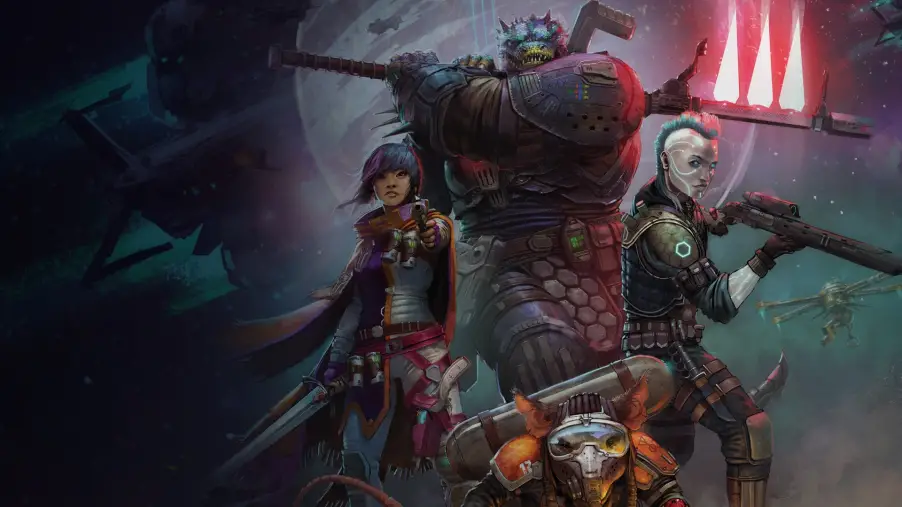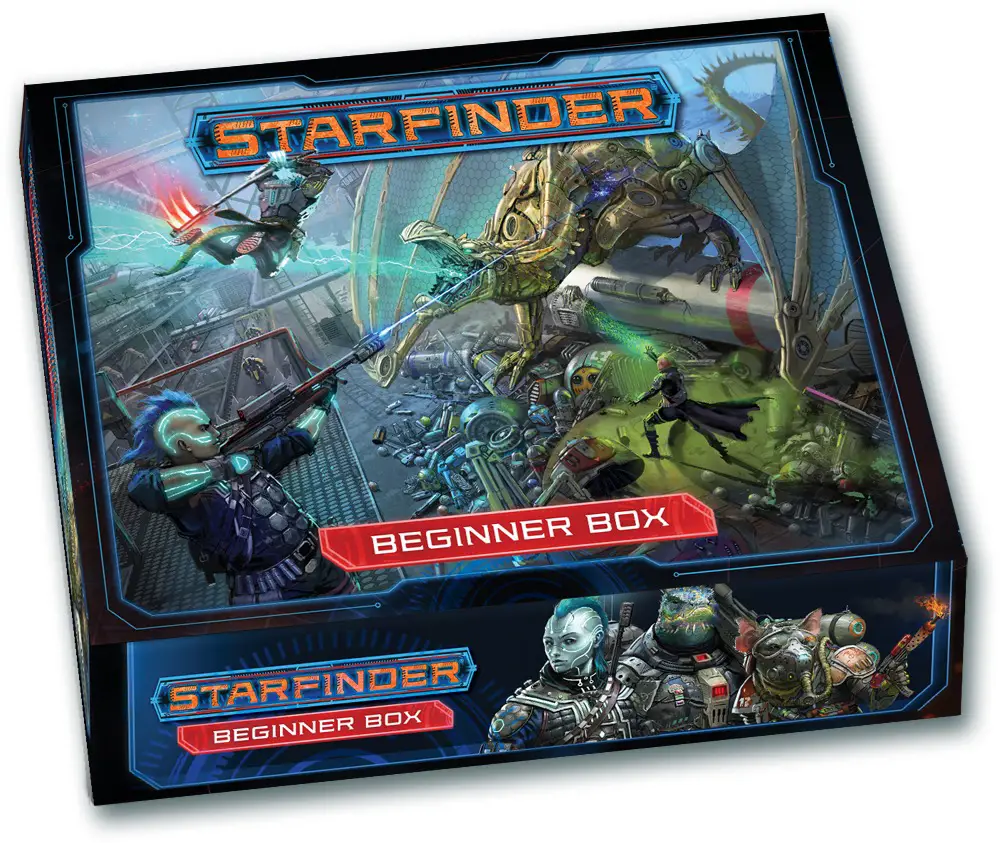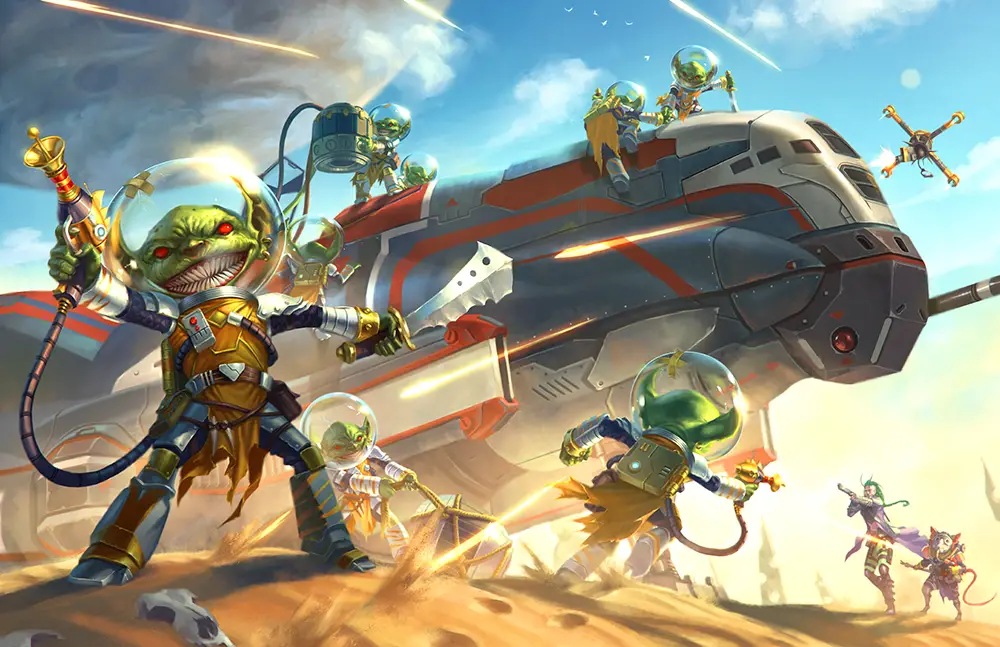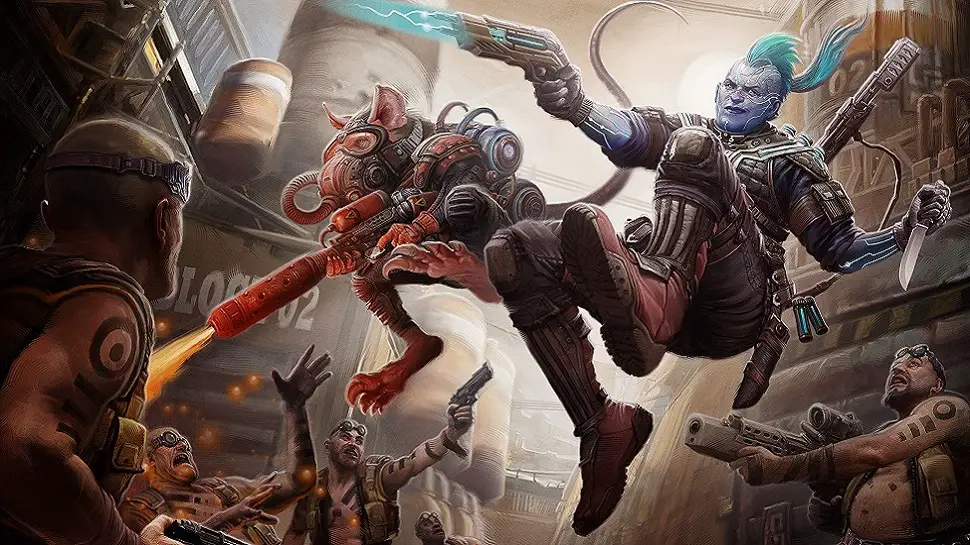
For any tabletop RPG group, one of the biggest challenges is getting into a new game. Whether it’s deciding which game the group wants to play, learning a new set of rules, familiarizing oneself with a different setting, or figuring out what the cost of entry would be to get the right materials and sourcebooks to run a campaign, going from scratch to assembling a group around a table is rarely an easy journey. That’s why beginner’s boxes are a godsend for groups who would rather experiment and take baby steps before committing to a new game. For a modest price, you can get a glimpse into a new world without having to learn 200+ pages of mechanics and setting information or spending hundreds of dollars on sourcebooks. With the Starfinder Beginner Box, Paizo hopes to bypass most of these issues and get players hooked on their science fiction universe with a single, neat package.
Like other beginner boxes, Starfinder Beginner Box comes with everything you need to play a simplified version of the full game. Here’s what’s included out of the box:
A 96-page Heroes’ Handbook, that covers basic rules, character creation, spells, equipment, and very basic setting information.
A 96-page Game Master’s Guide, which includes a starter adventure (called Steel Talon’s Lair), tips for gamemastering and building adventures, setting information, and useful references.
A thick, durable, double-sided playmat to use as a visual aid during exploration and combat encounters.
24 plastic pawn bases (including 3 large bases), and 87 character and creature pawns.
6 packets containing information for pregenerated characters.
6 blank character sheets, for those who’d prefer to make their own characters.
6 player aid cards, which serve as handheld reference tools for new players.
7 polyhedral dice (d4, d6, d8, two d10s, and a d20).
That’s quite literally a lot to unpack, so let’s go over each of these one-by-one.
Heroes’ Handbook
This book is the heart of the whole package, serving as the bible for beginner players, which introduces you to the kooky, over-the-top world of Starfinder. The book is very mechanics-focused, and details everything from the basic mechanics of play to creating and leveling up a character. It also includes information on equipment, spells, and general tips for participating in an RPG. If you’re hoping to play alone to try out some of what you learn, this handbook also offers a short 7-page solo adventure called, “Scoundrels in the Spike,” which can be particularly useful for newcomers. From the perspective of learning how to get started playing the game, it’s an incredibly well-written and concise guide to becoming a bonafide space badass.
Unfortunately, the Heroes’ Handbook has one glaring omission that’s pretty hard to miss — it has almost no information about the actual setting of Starfinder. You’ll read a paragraph or two about each of the playable races during character creation, or glean a few pieces of information while reading through the solo adventure, but aside from that there’s exactly one page dedicated to discussing the galaxy of Starfinder. That’s right — a single page. As a player, it’s pretty likely that you’ll be stepping into your first adventure as a complete stranger to the galaxy, which is going to make roleplaying in it pretty difficult.
Game Master’s Guide
No beginner box would be complete without a guide to help aspiring game masters plot a course for their players. The main draw in Starfinder’s game master guide is the adventure, Steel Talon’s Lair, which provides a short, 14-page odyssey for starting players to enjoy as their first step into the world. The adventure takes place in an abandoned futuristic space station and is focused mostly on dungeon-crawling and combat than narrative or world-building, which gives it a decidedly old school feel to it.
Aside from the adventure, the guide also provides tips on crafting your own adventures and gives some of the tools you might need to do so (trap suggestions, additional mechanics to utilize, and a list of sample adversaries that could be incorporated into a game). But, as with the Heroes’ Handbook, there is surprisingly little in the way of information about the setting. In total, there are ten pages in the Game Master’s Guide that are dedicated to describing the galaxy of Starfinder, which is precious little to go off of, even to use as a jumping off point. With how little this box actually includes in the way of describing the setting, it’s hard to get excited about the world, instead asking the GM to create one based on a slim set of established facts. Obviously, this is a beginner’s box, so you shouldn’t expect a complete detailing of the Starfinder galaxy and all it has to offer, but it’s hard to even get excited about diving into the universe and consider purchasing the full game with how little time is spent telling the players or the GM about what exactly they’re stepping into.
Double-Sided Flip-Mat
The mat that comes in the Starfinder Beginner Box is one of the more high quality maps I’ve seen, made of hard, durable, glossy material rather than the perishable paper grids that you might be more accustomed to. This means that you’re able to draw on the map with dry erase markers and clean it off to be reused at a later date, which can be invaluable for a budget-conscious GM. The downside here is that it’s hard to get the map to sit flat upon a table, as the creases from folding are hard to undo. One side is a map that depicts the dungeon-like abandoned space station that serves as the setting for the premade adventure included in the Game Master’s Guide, while the other side is a generic grid that can be used for anything else you can dream up.
As far as mats go, this one is pretty high quality and multi-functional. Though it might not be a selling point for the entire beginner’s box, it certainly adds value to a set that’s already packed with a lot of bang for your buck.
Pawn Bases & Pawns
One asset that comes in the beginner box and will doubtless prove invaluable to GMs are the cardboard pawns and plastic pawn bases. There are 87 creatures and character pawns in total, giving a wide variety of playable characters, non-playable characters, enemies, and creatures to use in the premade adventure, and any adventures going forward where these pawns might be repurposed. What’s more, the stands are quite well-made, and could easily be swapped out with whatever custom-made pawns a GM might need.
And while most of the pawns and pawn bases are made for small, humanoid characters, there are also several larger pawns, which can be held using the three large pawn bases. These are perfect for large creatures that might be the subject of a boss fight, or a large, non-humanoid NPC that you want to show to scale. For me, pawns and pawn bases are one of those things that you can never have too much of, and they’re pretty hard to find anywhere but a beginner box, so this is a pretty big selling point for the set.
Pregenerated and Blank Character Sheets
There are few things that can sell a potential player on diving into a new RPG world than seeing the unique badasses they will get to portray, and in that regard the Starfinder Beginner Box knocks it out of the park. Whether you’re interested in playing a creepy little mouse mechanic or an intimidating reptilian soldier, this beginner box has an option for everyone. Each pregenerated character sheet begins with an art and a brief description of the class that character represents. Opening the packet reveals a host of skills and stats that will need to be referenced when making skill checks or engaging in combat. And finally, and perhaps most importantly, on the back you can find a short biography of the character, including their personality and defining traits. The blank character sheets, on the other hand are, well, blank. But for players who prefer to go their own way, there are few things better than a blank page for you to fill with whatever your imagination can create.
This is one of the better selling points of the Starfinder Beginner Box. Where the package largely fails to provide a description of the setting and stoke interest in the players or GM to explore a rich universe, it succeeds in presenting compelling characters that will get players excited to become a star-faring adventurer. What’s more, the inside of the character sheet is annotated with explanations of each stat, skill, and value, which allows players to begin to understand why they’re succeeding or failing certain rolls and learn the mechanics as they play.
Player Aid Cards
Finally, the box contains an invaluable element for first-time Starfinder players: player aid cards. The player aid cards are double sided index cards that are meant to serve as a handheld reference for players. One side has a description of what can be done during a combat round, and some of the rules for rolling and healing, while the other side has a list of conditions that might impact the player and what the mechanical effects of those conditions are. As someone who has often found himself annoyed as his players take ten minutes to flip through a rulebook in the middle of an RPG session searching for something, I very much appreciate these references aimed at minimizing just that.
Starfinder Beginner Box
Great
At $40, the Starfinder Beginner Box is a great value for anyone looking to cut their teeth on the Starfinder system, and an awesome opportunity to sample Paizo’s space opera offering. However, with such a small amount of information about the actual setting, it may fall short of getting your group excited about the world itself.
Pros
- Great for those looking to pilot a Starfinder campaign
- High quality assets like the flip-mat and pawns make the box a great value
Cons
- Details on the Starfinder setting are appallingly few
- The starter adventure is little more than combat hallways




